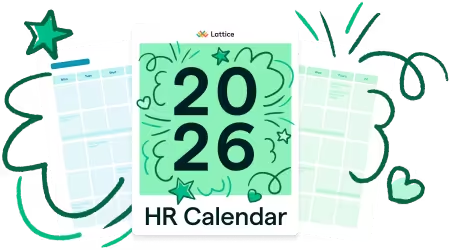Lattice Product Updates
Explore what's coming on our roadmap, see recent product updates, and learn more about Lattice's most innovative new releases.
Spring 2025
Goals & OKRs UI/UX Updates
Improved functionality and ease-of-use for Goals & OKRs.
Goals & OKRs UI/UX Updates
Improved functionality and ease-of-use for Goals & OKRs.
New Engagement Questions
Unlock deeper insights with powerful new features, including multi-select and skip logic questions.
New Engagement Questions
Unlock deeper insights with powerful new features, including multi-select and skip logic questions.
HR Help Desk
Streamline answers and route HR inquiries like company policy and benefit questions.
HR Help Desk
Streamline answers and route HR inquiries like company policy and benefit questions.
New Languages
Expand your global reach with new platform languages, including Portuguese, Swedish, Italian, Dutch, Danish, and Polish.
New Languages
Expand your global reach with new platform languages, including Portuguese, Swedish, Italian, Dutch, Danish, and Polish.
IDPs & Career Growth Plans
Receive AI-powered recommendations for growth areas and action steps to support your team’s professional development.
IDPs & Career Growth Plans
Receive AI-powered recommendations for growth areas and action steps to support your team’s professional development.
Review Packet Summaries
Quickly summarize performance reviews for unbiased calibration sessions.
Review Packet Summaries
Quickly summarize performance reviews for unbiased calibration sessions.
Summer 2025
Export to PPT
Export engagement survey results as presentation slides for easy and efficient sharing.
Export to PPT
Export engagement survey results as presentation slides for easy and efficient sharing.
Employee Health
Anticipate turnover risks and retain top talent before it’s too late.
Employee Health
Anticipate turnover risks and retain top talent before it’s too late.
Writing Assistant 2.0
More visible, more concise, and more useful suggestions.
Writing Assistant 2.0
More visible, more concise, and more useful suggestions.
More Goals & OKRs UI/UX Updates
Continued improvements to functionality for Goals & OKRs.
More Goals & OKRs UI/UX Updates
Continued improvements to functionality for Goals & OKRs.
Promotions in Calibrations
Access promotion information during calibration sessions for more informed decisions.
Promotions in Calibrations
Access promotion information during calibration sessions for more informed decisions.
Performance Improvement Plans (PIPs)
Foster employee development and optimize potential to drive performance.
Performance Improvement Plans (PIPs)
Foster employee development and optimize potential to drive performance.
Coming later this year
Succession Planning
Identify and nurture potential future leaders to fill critical roles.
Succession Planning
Identify and nurture potential future leaders to fill critical roles.
Employee Signatures
Boost accountability and compliance with signatures in reviews.
Employee Signatures
Boost accountability and compliance with signatures in reviews.
Raw Exports for Surveys
Have full control over your insights through raw engagement survey data.
Raw Exports for Surveys
Have full control over your insights through raw engagement survey data.
Chat with Lattice product data
Search and summarize qualitative data for insights and coaching.
Chat with Lattice product data
Search and summarize qualitative data for insights and coaching.
Take actions with Lattice product data
Initiate quick actions such as adding a 1:1 topic.
Take actions with Lattice product data
Initiate quick actions such as adding a 1:1 topic.
Custom Feedback Prompts
Personalize feedback prompts for more relevant, actionable insights.
Custom Feedback Prompts
Personalize feedback prompts for more relevant, actionable insights.
Performance Reviews Enhancements
Streamline reviews with more bulk actions, control, and better navigation.
Performance Reviews Enhancements
Streamline reviews with more bulk actions, control, and better navigation.
Goals & OKRs UI/UX Refresh
Improved functionality and ease-of-use for Goals & OKRs.
Goals & OKRs UI/UX Refresh
Improved functionality and ease-of-use for Goals & OKRs.
Custom Naming
Change the name of Lattice products to match your company’s nomenclature.
Custom Naming
Change the name of Lattice products to match your company’s nomenclature.
Analytics Insights & Data Visualizations
Ask data questions and get insights without needing to manipulate data.
Analytics Insights & Data Visualizations
Ask data questions and get insights without needing to manipulate data.
Changelog
At Lattice, innovation fuels our every move. Explore our latest product releases and updates, designed to make your Lattice experience even better.

Your people are your business
Ensure both are successful with Lattice.

